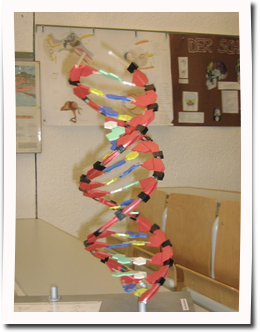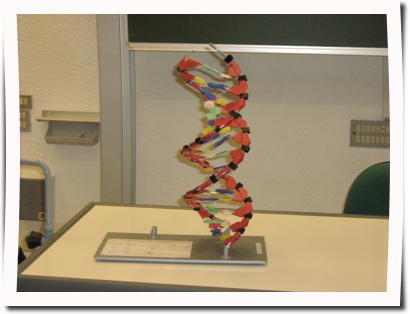Merler Sarah
Donnerstag, 6. Mai 2010
|
|
Viral vectors
Viral vectors are used to deliver genetic material into cells. This process is performed inside a living organism or in cell culture. Viruses have a specials mechanism to transport their genomes inside the cells they infect.The infected cells are described as transduced.
Microinjection: Genes by injection
An ultra fine cannula is used to inject genes into an animal cell. But so far it only works with animal cells and scientists have to do lots of research to find suitable genes, vectors and cell that are adapted to plant conditions.
|
Cuccarollo Ernest
Donnerstag, 4. Februar 2010
|
|
http://www.youtube.com/watch?v=hfZ8o9D1tus
|
Cuccarollo Ernest
Donnerstag, 7. Januar 2010
|
|
Which idea was Schroedinger fascinated with ?
Of the application of physics to the study of biology.
What did Schroedinger propose in his book?
His suggested investigating genes at the molecular level besides other issues.
What idea was Francis Crick driven by?
Schrödinger’s book triggered Crick to change his career plans from particle physics to biology.
When did Crick and Watson share the Nobel Prize and which discipline did it refer to?
Crick and Watson shared the Nobel Prize in medicine in 1962.
What idea did he hint at in the book: Life Itself: Its origin and Nature?
He hinted at the possibility that the origin of life might come from another planet.
What did scientists need to understand, although it was largely accepted that the DNA was the molecule of life?
They had to comprehend the structure of the molecule to be sure how it was working.
What kind of analysis did Watson and Crick make on DNA?
They figured that the molecule was made of two chains of nucleotides.
What information did Watson and Crick put together to get the structure of the DNA?
Chargaff’s discoveries about base pairs.
Why is DNA composed of two strands?
Because they separate during cell division.
|
Cuccarollo Ernest
Donnerstag, 7. Januar 2010
|
|

|
Cuccarollo Ernest
Donnerstag, 7. Januar 2010
|
|

- DNA stands for desoxyribose nucleic acid
- DNA is a very large molecule made up of a long chain of sub-units
- The sub-units are called nucleotides
- Each nucleotide is made up of sugar called desoxyribose, phosphate group -PO4 and an organic base
- The most common organic bases are: Adenine. Thymine, Guanine and Cytosine
- A molecule of DNA is formed by millions of nucleotides joined together in a long chain
|
Philipp Plattner
Dienstag, 22. Dezember 2009
|
|
Francis Crick’s family moved to London during the economic slump of 1929. At school Crick was especially interested in physics, chemistry and mathematics.
During the WW2 he joined the British Admiralty Research Laboratory, developing radar and mines for naval war. After the war he read Erwin Schrödinger’s book about Physical Aspects of the Living Cell. Crick switched from physics to biology.
Crick began working at the Cavendish Laboratory at Cambridge. In 1951, an American biologist, James Watson, joined the lab ant the two formed a close working relationship.
They were convinced that if the three-dimensional structure of a molecule known to play a role in passing genetic information-DNA-could be determined, the way genes are passed on might also be revealed. They were getting closer, as were other scientist chasing the same goal; a race was heating up. Watson and Crick shared the Nobel Prize in physiology/medicine in 1962. He also became director of Cambridge University’s Laboratory. He wrote two books: Of Molecules and Men (1966) and Life itself: Its Origin and Nature (1981).
|


















Kategorie:
dna